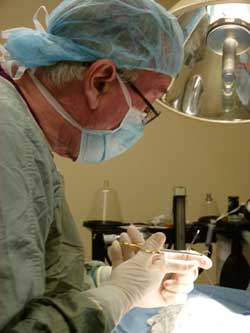When Your Pet Needs Surgery
The idea of a surgical procedure being performed on your pet is unsettling to say the least. This is why we go out of our way to make your pet—and you—as comfortable with the process as possible.
Our Facility
Modern and well kept, our surgical center has the capacity to handle most types of veterinary surgery. We feature the latest in monitoring equipment, and we provide an intravenous drip for every pet under anesthesia, as well as steadfast supervision throughout recovery.

Some of the more common surgeries we perform are:
- Spay and neuter
- Exploratory
- Lumpectomy and cyst removal
- Urinary tract
- Nose blockages
- Eye surgery
- Orthopedics
Our resident veterinarian, Robert Hallock, VMD, performs the majority of our general and orthopedic surgeries. Dr. Hallock has practiced at this location since its doors opened in 1971.
Anesthesia
Since most surgical procedures require anesthesia, we give your pet a thorough physical exam, including blood testing, prior to surgery. This helps us determine the type of anesthesia best suited for your pet or if there is an existing illness that needs to be dealt with before anesthesia can be administered. For senior or ill pets, additional blood tests, electrocardiograms, or X-rays may be required before surgery as well.
Sutures

Depending on the surgery, one of two different types of sutures will be used. For simpler procedures, absorbable sutures would most likely be placed under the skin. This type of suture dissolves on its own and does not need to be removed.
For occasional surgeries, traditional skin sutures or staples are required. The veterinarian will remove these, typically at 10 to 14 days after the surgery is performed.
Regardless of the type of suture used, you’ll need to limit your pet’s activity level, monitor the incision, and stay away from bathing your pet for 10 days after the surgery.
Pain Management
Due to the invasive nature of surgery, your pet may experience post-surgical pain. In most cases, a pain relief medication will be prescribed. The type of medication differs for dogs and cats, as well as the type of surgery performed. Any medications not administered by the veterinarian can be purchased from our in-house pharmacy.
Depending on the pet, and the type of surgery he or she undergoes, treatment with our class 4 therapeutic laser may by appropriate. We are one of the first clinics to utilize this technology and have found it effective with pet pain relief, reducing the use of medication, and speeding up pets’ recovery time.




